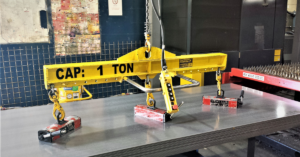18 February 2020

Whether it is the hook of an overhead crane, hoist, monorail or jib crane, it may be much safer and more efficient to use a “below-the-hook” attachment to mobilize an irregularly shaped or sized load.
Using a “below-the-hook” hoisting appliance means any hoisting appliance (not including slings) that ensures a connection between a load and the overhead crane hook used to lift the load. Note that slings are “hoisting accessories” while lifting beams (bars, spreader beams), hooks, tongs or lifting clamps, suction cups and magnets are “hooking accessories”.
LOAD CHARACTERISTICS
All these hooking accessories are used to lift a load with a length, weight or shape that requires an adapted and safe hooking system. For example, a spreader beam is useful for lifting long loads and preventing the load from tipping or sliding off the slings. Suction cups or magnets are generally used to lift metal sheets or plates.
In the case of an irregularly shaped load or a load made of different materials, the centre of gravity will not be in the centre of the load. The method of attachment must, therefore, take account of this factor to avoid an occupational accident or a falling load due to a centre of gravity that has shifted.
WHY SHOULD YOU USE A BELOW-THE-HOOK HOISTING APPLIANCE ?
1) For greater effectiveness
2) For evident reasons of safety
3) To avoid the fall and breakage of expensive parts
4) For specific handling (rotation, positioning)
Pont Roulant Protech specialists can advise you on the best lifting equipment adapted to your needs.
